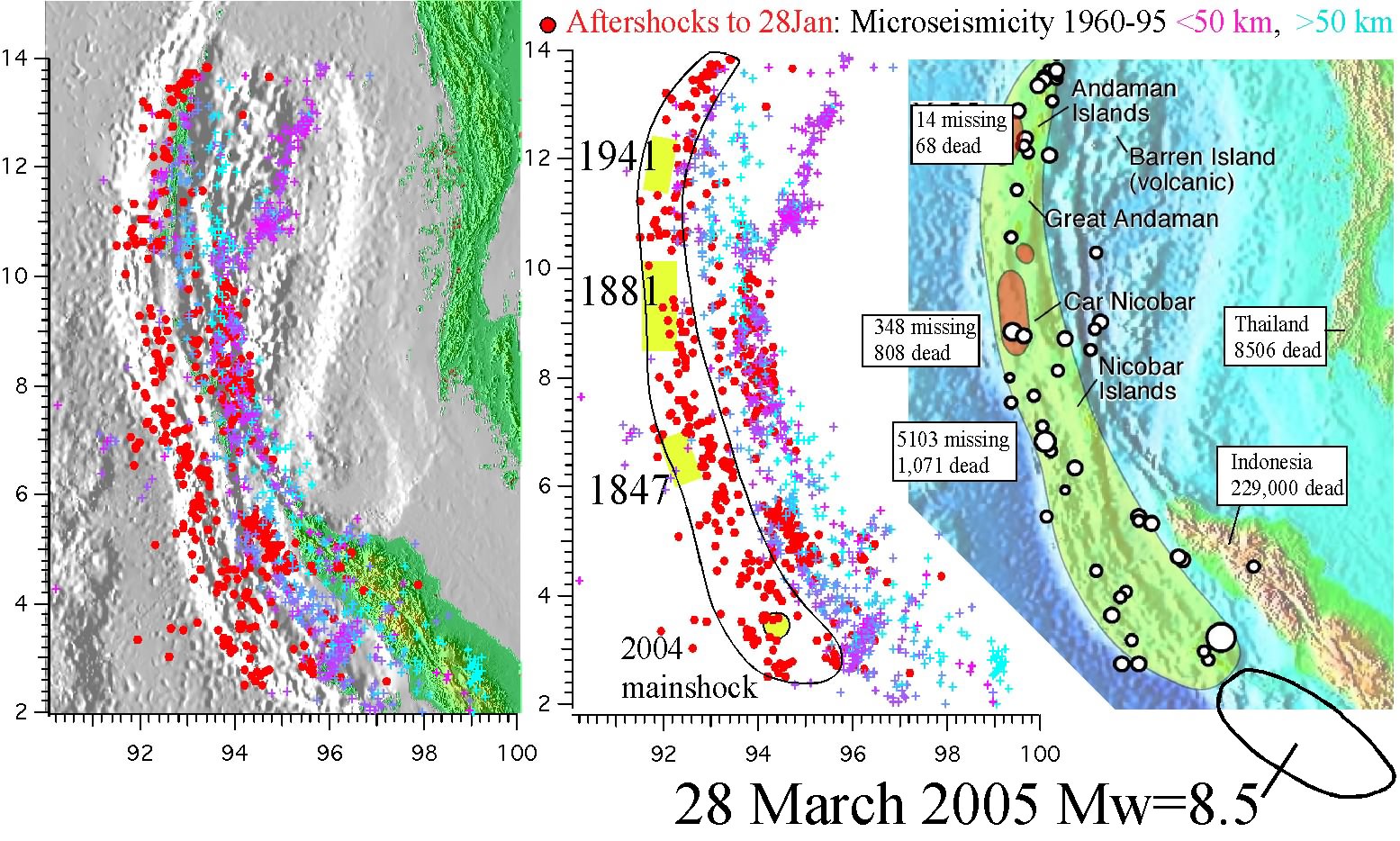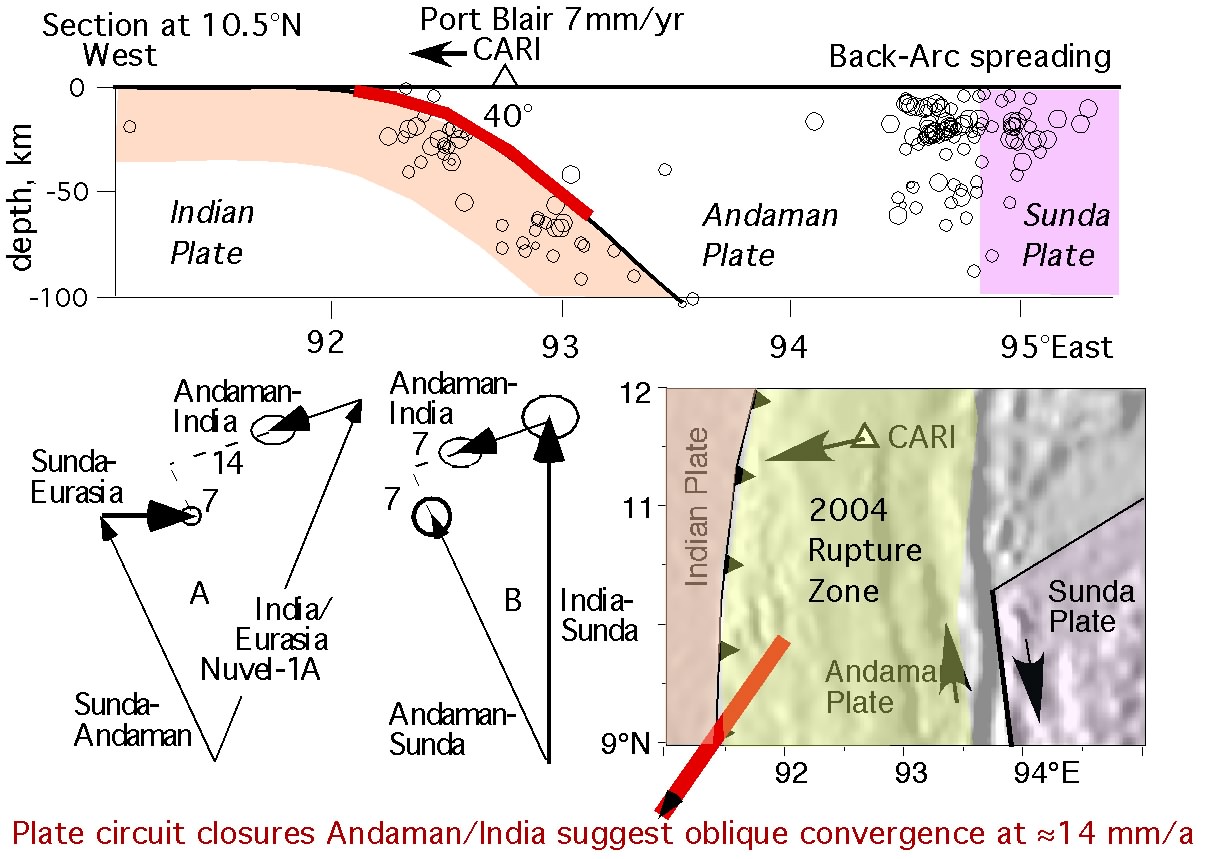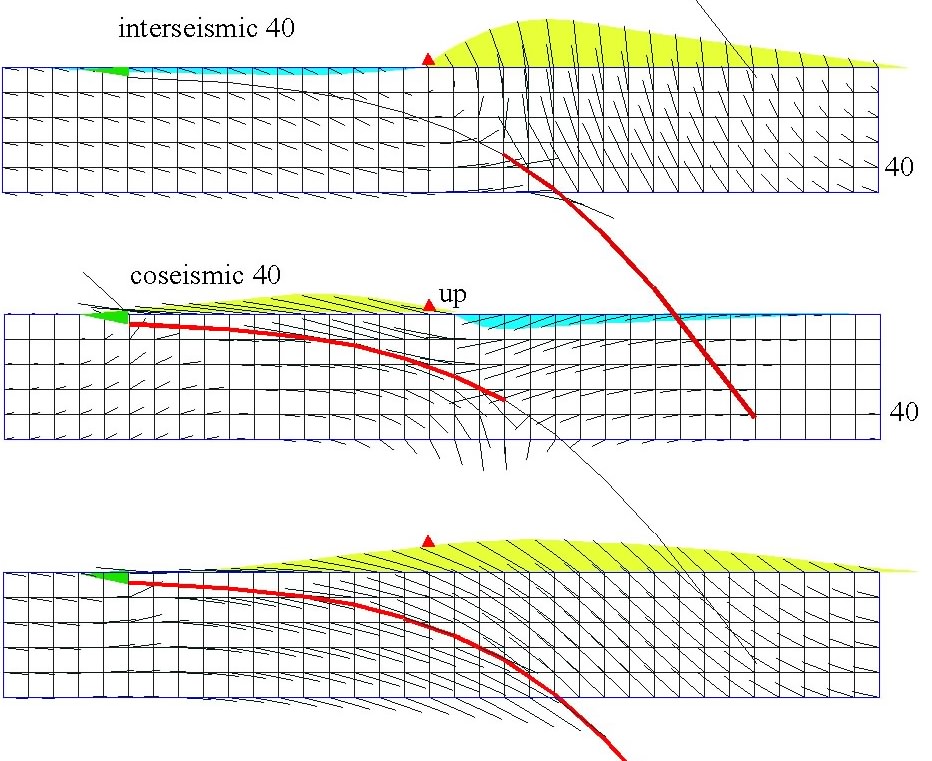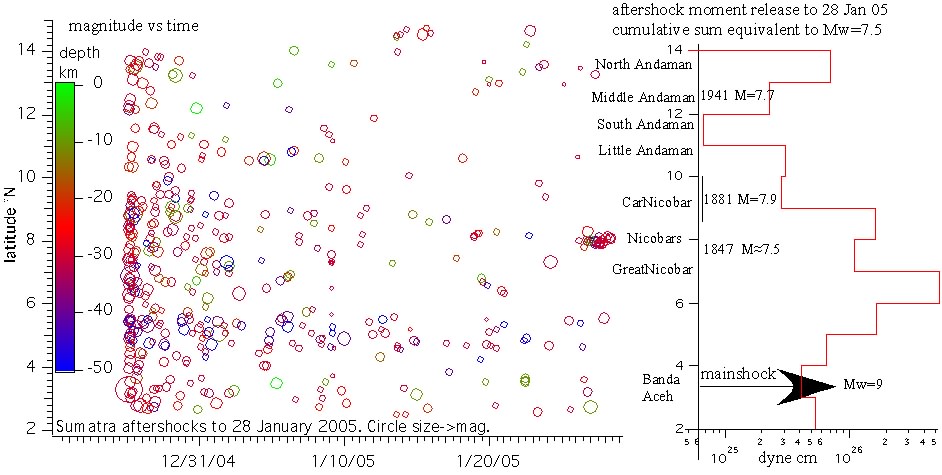Indonesia/Nicobar/Andaman
Earthquake
Mw=9.0 NEIC Epicenter 3.32¡N, 95.85¡E
Rupture 1600 km to north, >130 km downdip . Preliminary rupture area 180,000 sq km.
Deathtoll 298,055 (Guardian 29 Jan 2005)
(228,948 Indonesia, 43,382 Sri Lanka, 16,389 India, 8.506 Thailand
The earthquake ruptured >1300 km of India's eastern plate boundary, and although several MÅ8 earthquakes have occurred there, its M=9.3 magnitude has no historical precedent. The plate boundary separates the NE moving Indian plate from the Andaman Plate (also known as the Burma microplate). Direct measurements of convergence in the Northern Andamans are imprecise but the relative velocity appears to be Å14 mm/year. Some of this relative displacement is manifest as strike-slip motion on the submarine Andaman fault to the east, on which aftershocks have been occurring since 26 Dec. For general, and recent, seismic information consult Stacey Martin's ASC page. The map below shows the 2004 rupture and the approximate locations of ruptures in 1847, 1881 and 1941 (see relocated aftershocks and rupture zones in Bilham et al. (2005). Although the high frequency p-wave train, aftershocks, and surface deformation, indicate plate boundary slip occurred for almost 1300 km, the bulk of the plate-boundary displacement propagated much slower than the seismic rupture and was manifest as deep rapid afterslip. Click map for larger image showing the location of the 1861 Sumatra rupture. The main rupture exceeded 160 km in width and occurred on the shallowest part of the subduction zone from 4 km to approximately 50 km depth, largely to the west of interseismic seismicity in the past century .
Kerry Sieh's reports from the epicenter
Geological Survey of India Field Report 12 Jan (1Mb pdf)
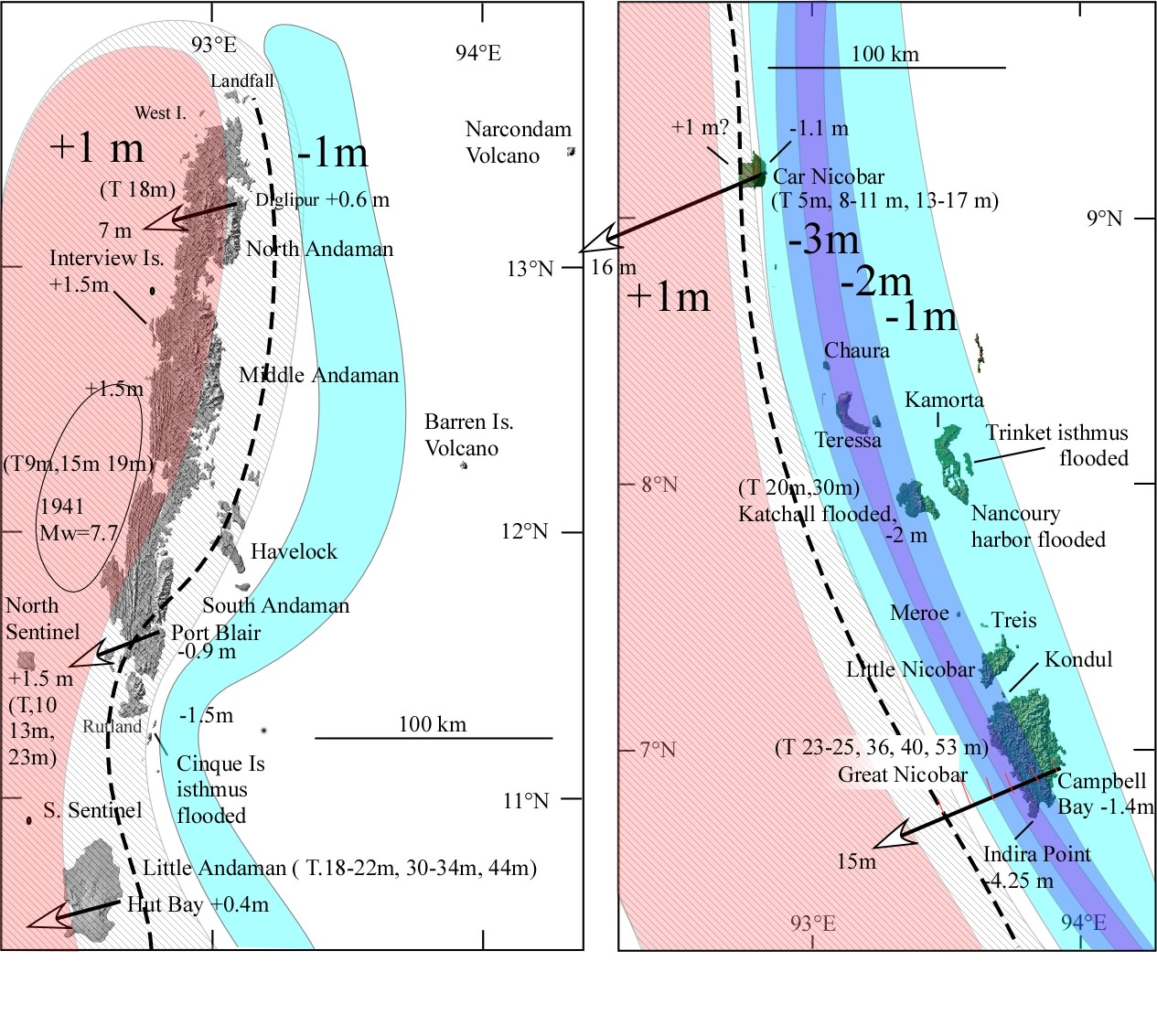
POST SEISMIC GPS .list of sites.
The tsunami was recorded at
Intensity data from the islands remain sparse, and although shaking intensities on the whole appear to have been low, reports from Rutland island (John Paul) indicate that people had difficulty standing, that grass roots were pulled from the ground by people trying to stabilize themselves, and that they incurred a feeling of nausea. This suggests local Intensities greater than VIII.
DAMAGE REPORTS http://tsunami.and.nic.in/damages.htm: 16 Jan 5625 missing,
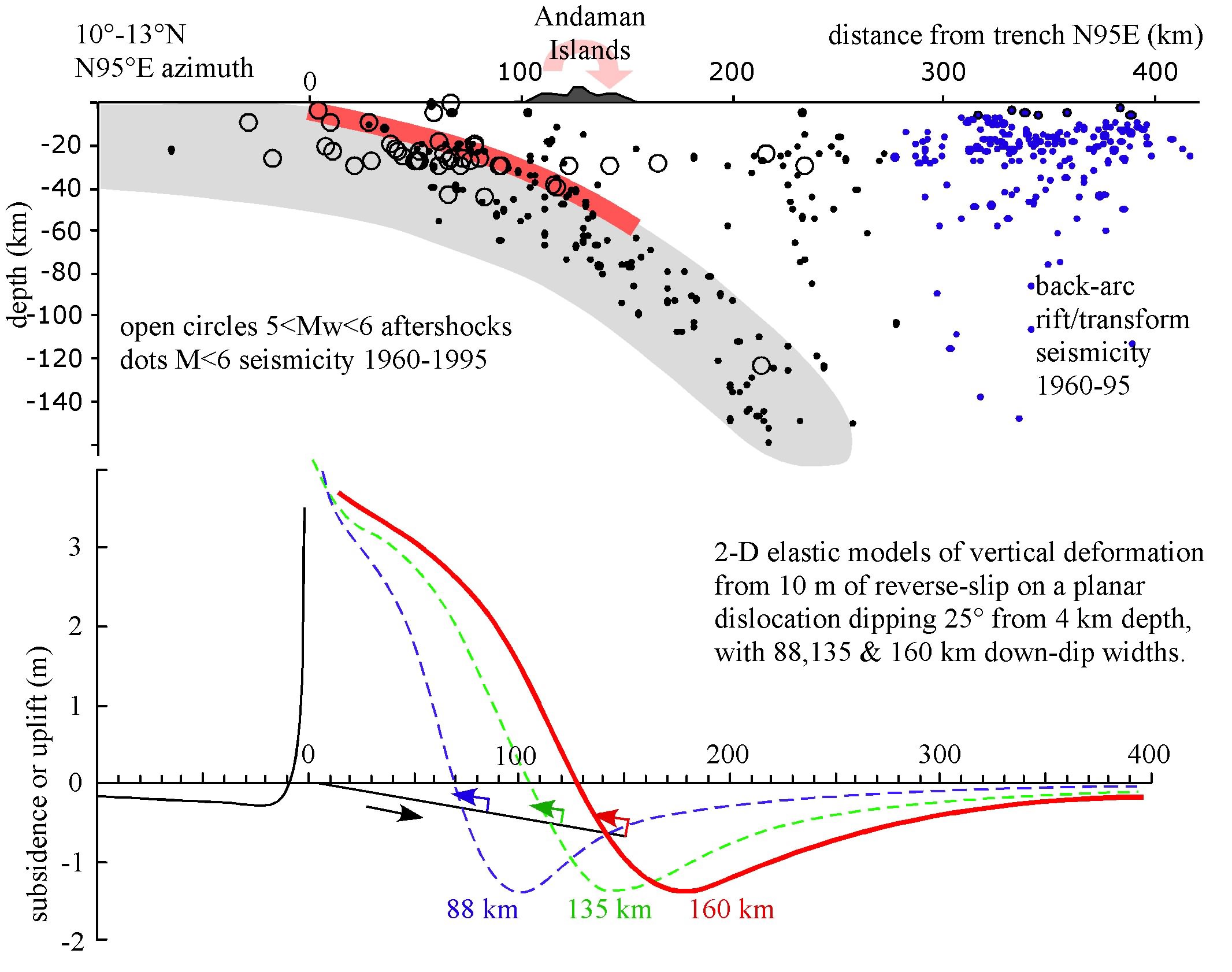
Geological studies in the Andaman and Nicobar Islands since 1830 report marine terraces, uplifted coral reefs and
Global Sea level
Great subduction earthquakes raise sea level globally due to the same coseismic shallowing of the ocean floor that resulted in the tsunami*. The Chile 1960, and Alaska 1964 earthquakes are calculated to have increased sea level by 1.7 mm and 0.7 mm respectively. The current earthquake may raise sea level by approximately 0.5 mm, adding roughly 30 % to this year's annual rise of sea level. Earthquake induced increments are slowly removed between large earthquakes so that there is no net cululative rise in sea level from large events. *Bilham, R. and S. Barrientos, Great earthquakes and sea level, Nature (Lond), 350, 386, 1991. The earthquake resulted in seiches in North America. A 70 minute duration 4.5 nanoradian surge to the NE was recorded near Seattle in Washington state. The free oscillations of the Earth are expected to continue beyond mid January.
Rupture and afterslip propagation
Previous tsunamis in the Bay of Bengal
1881 earthquake and tsunami. Earthquakes on 31 Dec 1881 and 26 June 1941 caused 1 m high tsunamis
to run up on India's eastern coast (read accounts of 1881 tsunami), and the waves from the Krakatoa eruption of
1883 caused a measured maximum amplitude of 56 cm (Walker, 1884; Ortiz and Bilham, 2002, pdf), contrary to recent assertions of larger amplitudes claimed by several authorities. The 1881
tsunami amplitude attained 1.04 m at Chennai (at low tide) and was caused by 2.7 m of slip on
a 150 km by 50 km patch (Mw=7.9) centered on Car Nicobar.
1941 earthquake and tsunami. The 1941 earthquake
( Mw=7.7) occurred just before the Japanese occupation of the Andaman Islands and
appears to have ruptured the region near South Andaman Island. No
tsunami records have survived for the 1941 earthquake, and despite an unattributed claim of 3000 dead [Murty and Rafiq, 1991], no official records confirm these numbers. Although it is possible that
official damage data were deliberately suppressed for this earthquake, as they
were for the wartime Ms=7 Mymensingh earthquake in what is now northern
Bangladesh, a more likely explanation is that no deaths occurred. Were the earthquake Mw=7.7, the tsunami amplitude would have been less than 1 m.
Volcanoes: a mud volcano on Middle Andaman island erupted with renewed vigour (3 m mud-fountaining, 27 Dec. photo of ignited gas flame courtesy Vineet Gahalaut), and although some press reports mentioned lava this was a reporting error (policeman do not erect barricades around lava flows).
Nicobar/Andaman written history see Kurz and
Future Ruptures
The plate boundary immediately north of the Andaman Islands has not slipped in historical time. Near the Bangladesh shoreline an inferred major earthquake occurred near Chittagong in 1769 that resulted in the sinking of an island presumably due to lateral spreading, however, spatial coverage of this earthquake is insufficient to be certain that it much exceeded Mw=7.5. Earthquakes on the Saigang fault, the onland continuation of the eastern plate boundary with the Eurasian plate are even less well documented, although it is certain that several major gaps remain that could sustain Mw=8 earthquakes. It appears unlikely that a significant tsunami can be generated from the remaining sub-marine portion of the Andaman plate boundary, and the renewal time for events such as that recently witnessed is many hundreds of years. A thousand years may need to elapse before 14 m of slip can be renewed on the plate boundary near the Andaman Islands at its current inferred convergence rate.
Implications for Himalayan Earthquakes
The historical inventory of Himalayan earthquakes has grown substantially in the past decade. Some have been downgraded in magnitude leading to the conclusion that only 30% of the Himalaya have slipped in the past three centuries. Newly discovered earthquakes occurring in the 10th to 16th centuries may have been much larger than recent events since some of these resulted in rupture of the frontal thrusts of the Himalaya, that did not accompany those that occurred in the past two centuries. In that the Sumatra/Nicobar/Andaman earthquake ruptured regions shallower than the major earthquakes in 1881 and 1941, a similar scenario can be invoked in the Himalaya, near incomplete ruptures of the plate boundary like those that occurred in 1833 and 1905. An implication of the 2004 earthquake is that M>8.5 earthquakes with >600 km long ruptures could rupture through these areas. See Centennial review of slip potential near Kangra.
Could we have predicted the 26 Dec 2004 tsunami?
We have no evidence to believe that M=9 earthquakes occur repeatedly as >650-km-long ruptures with 10 m of slip along the Andaman/Nicobar plate boundary. Certainly we shall now seek such evidence. On the other hand we knew that tsunamis have occured on both India's Malabar (1524, 1945) and Coromandel coastlines (pdf). At a June 2004 NASA hazards conference in Bangalore, a maximum wave height of 3 m was estimated might immerse parts of Chennai from a possible Andaman/Nicobar earthquake. We are currently unable to forecast the probability of tsunamigenic earthquakes near India, and it is thus unlikely that coastal defences would have been implemented even for the Kalpakkam nuclear power plant (shut down, and evacuated but not damaged 26 Dec) had a tsunami hazard study been completed. However, a credible warning system could follow from such a study, since the coast of India is sufficient distance to provide a 2 hour warning of an Andaman or Nicobar initiated tsunami. Attempts were indeed made by tsunami experts on 26 December to alert responsible officials to an impending tsunami in the hours after it had been initiated and before it arrived in India and Sri Lanka.
Global Tsunami defenses
In that the parameters of great earthquakes can be automated within tens of minutes, and forward projections made of the approximate path of an advancing tsunami, the scientific community has been arguing for tsunami warning systems for coastal communities outside the Pacific for some time. Realtime alerts of inbound tsunamis require relatively simple monitoring systems at tele-tsunami distances because the damaging wave is usually preceded by slow anomalous sea level excursions. A simple real-time tsunami monitoring system has been demonstrated by Modesto Ortiz on the Mexico coastline, The Caribbean, the Mediterranean and the Atlantic coastlines are all vulnerable to tsunamis. Action plans for these communities could be as simple as an automatic alerts to radio stations, automatic voice messages and cell phone messages, and public sirens. More advanced plans might include mandatory earthquake-resistant stilt-houses, or numerous tsunami shelters (elevated platforms), with occasional tsunami drills. The ultimate defense for locally generated tsunamis is a tsunami barrier along the coast to protect villages, as has been implemented in parts of the Japanese coast, however, this is difficult for long featureless coastlines where it effectively demands the construction of a continuous marine dike.
Free Web Site Counter
